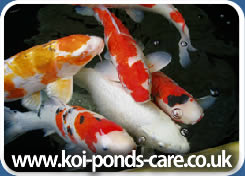
Types Of Koi ::
There are many types of koi for example koi carp, Nishikigoi, Japanese Koi, all are names applied to coloured varieties of the common carp Cyprinus carpio. Whatever name you choose to call them, Koi are truly one of natures wonders and add a magnificent palette of colour to any garden fish pond. Since their early beginnings in the Nigata region of Japan in the Nineteenth century, Koi have been selectively bred and developed to produce the many varied types of coloured Koi available today.
The earliest types of Koi produced were bred from the fish kept by rice farmers to supplement their diet. From time to time coloured mutations would appear amongst these carp and some were kept as pets. It seems most likely that the first types to appear were the red and white varieties now referred to as Kohaku. From these early beginnings breeders were able to breed other colour varieties the next types to appear were Sanke and Showa, both are three colour patterns of red, white and black but with different proportions of the three colours.
The pictures below show the most common types of Koi carp now available with a brief description of their origin where known.

Ai GoromoA white koi with Red pattern like a Kohaku, but the red of each scale has a dark blue edging. The reticulated pattern formed looks stunning on a good Ai Goromo. |

Aka BekkoThis is a red koi carp with small black patterns. |
|---|---|

AsagiThis is one of the oldest varieties of koi and still popular today. The ideal Asagai should have a clear white head and a symmetrical net like pattern of pale blue scales. Asagai also have red / orange colour (Hi) spreading up from the belly to the midpoint (lateral line), sometimes this carries on over the back creating a Hi Asagai. The red colour is also present in the fins in these types of koi. |

BekkoA white koi with small black patterns. The white should be pure white and the black confined to the top half of the body. |

Cha GoiA brown koi, the brown colour can vary from deep chocolate brown to light, almost olive green in appearance. Despite its drab appearance this is one of the most popular types of Koi due to its friendly nature and ability to rapidly grow to a large size. A large Cha Goi is an imposing sight in any koi pond and sets off the brighter colours of its more glitzy cousins. |

Gold OgonA metallic gold coloured koi, the colour varies from a yellow (Yamabuki) colour right through to deep gold. this is one of the oldest types of koi and although only a single colour fish, large Ogon have a particularly imposing presence in a Koi pond. |

Hi UtsuriA black koi with red (hi) pattern. The pattern style is basically the same as Shiro utsuri but with red instead of white. Not a particularly popular variety , many specimens develop black specks (shimis) on the red pattern rather than pure red. |

KohakuA white koi with red (hi) pattern. In a show grade fish the base colour should be a pure snow white with no black speckles (shimis), the red colour should be deep and even. Kohaku are available in many different patterns and are still regarded as one of the most attractive types of Koi even with the massive selection of varieties available today. |
|
|
|

Platinum OgonMettallic Silver Koi, like the Gold Ogon this variety looks fantastic when it reaches jumbo size with its deep metallic shine complementing the patterned varieties of Koi in the pond. |

SankeA white Koi with red (hi) and black (sumi) pattern, the black is typically only on the upper part of the body above the lateral line and is generally in small patterns rather than solid blocks. Sanke are another of the early types and one was exhibited as early as 1914 at the Tokyo. |

Shiro UtsuriA black koi with white pattern. The black appears as large blocks that come from the lower part of the Koi and right over its body in a similar way to that of Showa. |

ShowaA black koi with red and white patterns. A typical early Showa had large areas of black in solid blocks with relatively small areas of red and white patterns sitting on top of the black. This solid appearance of the black is one of the main ways of distinguishing Showa from Sanke where the black is generally in much smaller amounts and sitting on top of the white and red. Modern patterns of Showa have confused this distinction somewhat as the style has moved towards smaller amounts of black and an appearance that may be much closer to that of a Sanke. |

Sumi GoromoA white koi with black pattern and each scale reticulated with red. This type of Koi looks very similar to the Ai Goromo at first. |

ShusuiA Koi with only a few large mirror (doitsu) scales, the Shusui was created by crossing Asagai with mirror carp. The name given to any types of Koi with these large scales and the majority of the body scale-less is Doitsu. This is derived from the German description for food carp originally bred in this variety to make them easier to prepare for the table. Today many types of Koi carp are bred in this style, hence it is possible to see Doitsu Kohaku, doitsu Sanke etc. |
Return To Top Of Page


